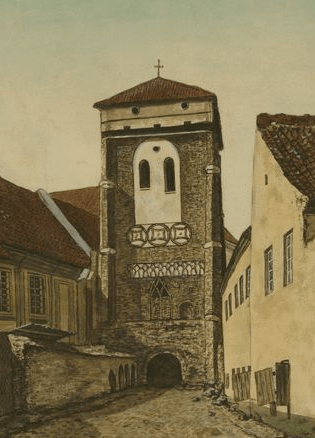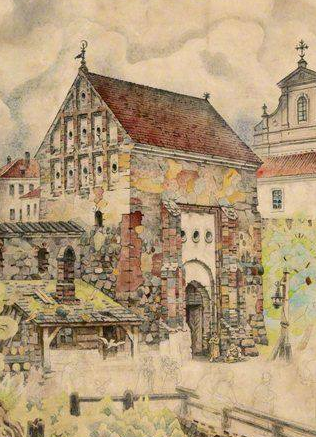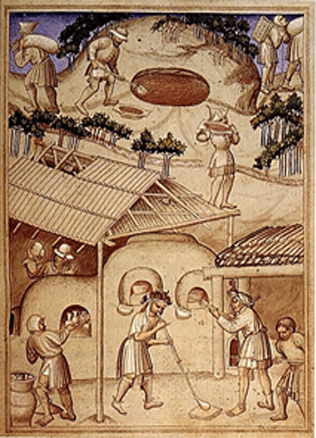Celebration in Vilnius: John III, the Duke of Finland, Marries Catherine Jagiellon in 1562
The international conflict around Livonia, known as the Livonian War (1558–1582), drew in the Grand Duchy of Lithuania, Poland, the Grand Principality of Moscow as well as Scandinavian countries, the Duchy of Prussia, and the Holy Roman Empire. All sides used the power of political diplomacy in addition to military actions to reach their goals. The project of marrying Catherine Jagiellon (1526–1583), a sister of Sigismund II Augustus, King of Poland and the Grand Duke of Lithuania, was one of such endeavours. While taking part in the conflict, Muscovy and Sweden also expected to benefit from the marriage of Catherine, dubbed by historians “the new Helen”.
The fight for the hand of the Jagiellonian
Ivan IV, the grand duke of Moscow, who initially enjoyed success in the undeclared war against Lithuania for Livonia, was first in a queue to offer his hand to Catherine. After the death of his eighth and last wife Anastasia, marriage with the representative of the House of Jagiellon would have paved him way to the throne of the GDL after the death of the last Jagiellonian ruler, who was childless. In addition to that, Ivan would have solved the question of occupation of Livonia. The negotiations with the delegation of Muscovy sent to Vilnius in 1561 to discuss the matter bore no fruit, though. Military actions resumed in Livonia, while Livonia itself entered the war in November 1561 as an autonomic province of the GDL. That same year, Sweden unexpectedly put forward its claims for Livonia. Eric XIV Vasa, the King of Sweden, seized Tallinn in June 1561. Sigismund II Augustus, who wanted to forge an alliance with Sweden against Muscovy and to secure a loan from Sweden, was involved in negotiations with Eric XIV’s foster-brothers.
John III Vasa (1537–1592), the Duke of Finland at the time, who proposed financial assistance, was to marry Catherine, while Magnus (1542–1595), the prince of Sweden who was nineteen then and suffering from mental illness, was offered Anna Jagiellon, 38, as his wife.
However, Eric XIV seized Pärnu in Estonia the following year and warned off his two brothers from marrying Jagiellonians. John III, who wished to assert his independence as a duke of Finland, ignored the instruction of the king. He arrived in Gdansk in 1562 and, from there, travelled to Vilnius to continue the negotiations about his marriage.
Aware of the conflict between the two younger Vasas, Sigismund II Augustus did his best to postpone the wedding between his sister and John III. However, eventually he set an earlier date for the marriage, because the Duke of Finland insisted on that and even gave 120,000 zlotys to his brother-in-law-to-be in loans.
According to the contemporary witness Łukasz Górnicki, “the king visited the princesses in the early evening and, as the custom requires, asked Catherine in the presence of her sister if she agreed marrying the duke in her free will. The princess replied she wished no other situation for herself than that she was in at the time. […] The king left then and, after discussions with the Voivode of Vilnius and priest Miszkowski and after conveying the good news to the duke, set the date of wedding for Sunday, the fourth of October 1562. The king also notified the Lithuanian nobility, all who were there then, to arrive on the set day together with their wives.”
A royal feast
As a result, the capital of the GDL saw the celebration on 4 October 1562, the day when Catherine, 36, the youngest sister of Sigismund II Augustus, married the Duke of Finland John III Vasa, who was eleven years younger.
The festivity, which lasted for the whole week, appeared to become one of impressive events within the walls of the Palace of Grand Dukes of the Lower Castle in the middle of the 16th century, the event that consolidated the importance of Vilnius as the capital of the GDL.
John III Vasa, accompanied by 300 riders, arrived in Vilnius on Friday, October 2. Sigismund II Augustus, whose escort of courtiers was several times bigger, left the limits of the city to meet the Finnish duke. His horsemen, in splendid attire, were divided into four squadrons. According to the contemporary who observed the event, “the first one included 1,500 warriors dressed so fabulously in hussar or, more precisely, in Hungarian fashion wearing different colourful clothes made of silk and other fine fabrics and featuring the innumerable plenty of most wonderful feathers which surprised the spectators greatly; people had a lot of everything to stare at, because all the horses were as beautiful and superb as one can possibly imagine speaking of the most beautiful and best horses, most of whom were decorated with bridles of pure silver or, in some instances, of gold. The second squadron consisted of 2,000 Braunschweig, or German-type, horsemen who were most good-looking in terms of their attire and who rode horses no less beautiful than the others, decorated with plenty of tassels that added to the splendour. The third squadron consisted of 1,000 Cossacks or, more precisely, Tatar horsemen, some of them wearing gold-woven or silk clothes and all riding most beautiful horses and all carrying bows and arrows. The last [squadron] consisted of 1,500 horsemen of the royal guard who rode all dressed in uniformly made German-style clothes of blue and grey fabric. […] Their attire was so splendid and their horses so beautiful and so superbly harnessed that they inspired awe among all who saw them, especially the Swedes.”
The introduction of the Duke of Finland to the Lithuanian aristocracy took place on October 3 at the Lower Castle in Vilnius. In accordance with Sigismund II Augustus’ instructions, highest state officials gathered in the palace accompanied by their wives. After the conditions of the marriage had been finally set, the wedding took place on Sunday, October 4th in the cathedral church of St. Stanislaus. In the morning, the Duke of Finland, escorted by a large group of noblemen, arrived in the castle and then everybody went to the cathedral. The act of marriage was carried out there with Walerian Protasewicz, the bishop of Vilnius, bestowing the sacrament of matrimony. According to Bernardo Soderini, the envoy of Florence, a huge party took place in the Castle of Vilnius after the ceremony of marriage; people rejoiced, while in the evening the duke was left with his wife. The celebration lasted for the whole week and included dancing, various games and tournaments. The newlyweds whiled away in the Palace of Grand Dukes of the Lower Castle. It was there that the list of Catherine’s belongings had been compiled before she left the palace. Leaving Vilnius, Catherine Jagiellon took with her a rich dowry, a big part of which was expensive jewellery, including a 6,400 zloty golden necklet featuring five emeralds and pearls, and another necklet with three diamond plates, valued as much as 16,800 złotys, as well as other decorations, expensive vessels, and clothing.
The fortunes and hardships of the newlyweds
On October 12th, the newlywed couple left for Riga, accompanied by their personal court and Polish courtiers, before travelling from Riga to the residential castle of the Duke of Finland in Turku. However, the riksdag summoned by the King of Sweden Eric XIV accused John III of high treason for acting against the king’s order. The Swedish troops arrested the duke and his wife in early 1563 and imprisoned them in the Gripsholm Castle west of Stockholm. Catherine had no other option but to share the straits of captivity with her husband. During the talks between Muscovy and Sweden, in 1564 and 1567, the sides negotiated their alliance and Ivan IV demanded surrendering him the imprisoned Catherine Jagiellon.
His threats proved void though, because John III’s wife refused to leave her husband and her destiny was to accomplish just what was engraved on her wedding ring: “Nothing but death.”
The couple was freed in 1568 and the next year Catherine became a queen after John III was crowned the King of Sweden. Their son Sigismund III Vasa (1566–1632), who was born in captivity, was the first ruler of the Vasa dynasty in the Polish and Lithuanian Commonwealth.
Literature: Vilniaus Žemutinė pilis XIV–XIX a. pradžioje: 2002–2004 m. istorinių šaltinių paieškos, sud. R. Ragauskienė, Vilnius, 2006, p. 231–234 etc.
Raimonda Ragauskienė



